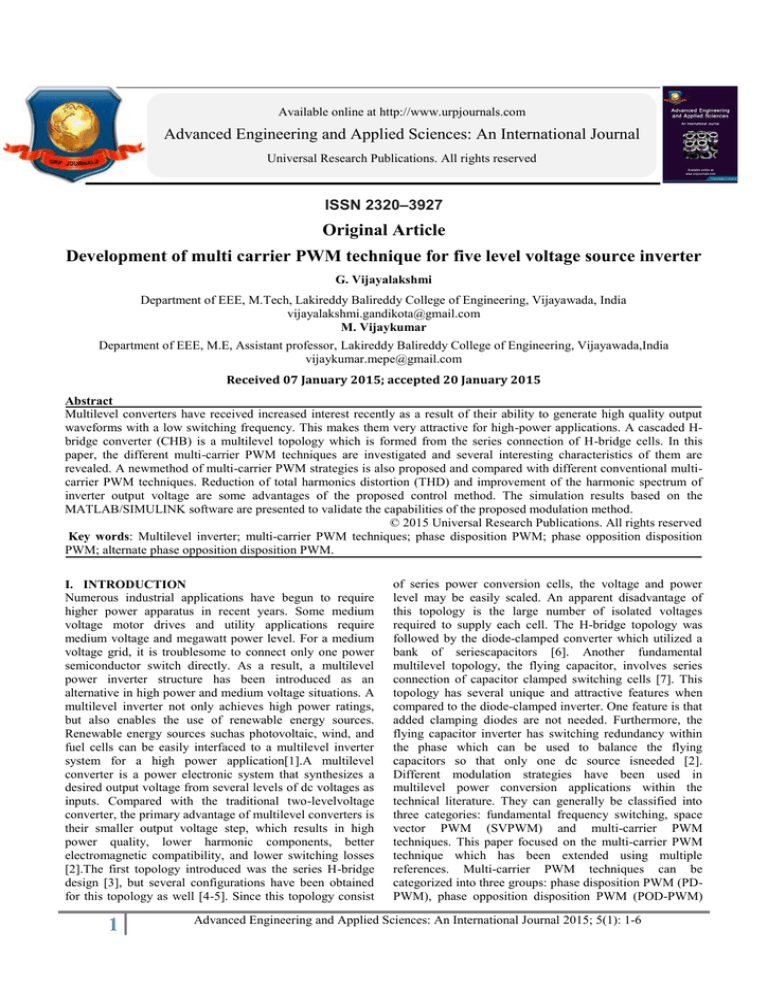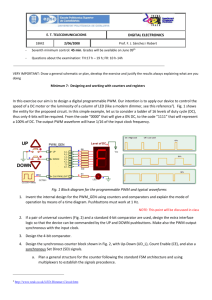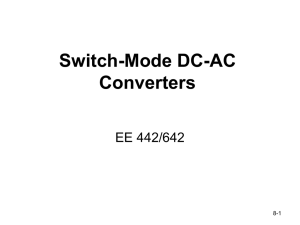
Available online at http://www.urpjournals.com
Advanced Engineering and Applied Sciences: An International Journal
Universal Research Publications. All rights reserved
ISSN 2320–3927
Original Article
Development of multi carrier PWM technique for five level voltage source inverter
G. Vijayalakshmi
Department of EEE, M.Tech, Lakireddy Balireddy College of Engineering, Vijayawada, India
vijayalakshmi.gandikota@gmail.com
M. Vijaykumar
Department of EEE, M.E, Assistant professor, Lakireddy Balireddy College of Engineering, Vijayawada,India
vijaykumar.mepe@gmail.com
Received 07 January 2015; accepted 20 January 2015
Abstract
Multilevel converters have received increased interest recently as a result of their ability to generate high quality output
waveforms with a low switching frequency. This makes them very attractive for high-power applications. A cascaded Hbridge converter (CHB) is a multilevel topology which is formed from the series connection of H-bridge cells. In this
paper, the different multi-carrier PWM techniques are investigated and several interesting characteristics of them are
revealed. A newmethod of multi-carrier PWM strategies is also proposed and compared with different conventional multicarrier PWM techniques. Reduction of total harmonics distortion (THD) and improvement of the harmonic spectrum of
inverter output voltage are some advantages of the proposed control method. The simulation results based on the
MATLAB/SIMULINK software are presented to validate the capabilities of the proposed modulation method.
© 2015 Universal Research Publications. All rights reserved
Key words: Multilevel inverter; multi-carrier PWM techniques; phase disposition PWM; phase opposition disposition
PWM; alternate phase opposition disposition PWM.
I. INTRODUCTION
Numerous industrial applications have begun to require
higher power apparatus in recent years. Some medium
voltage motor drives and utility applications require
medium voltage and megawatt power level. For a medium
voltage grid, it is troublesome to connect only one power
semiconductor switch directly. As a result, a multilevel
power inverter structure has been introduced as an
alternative in high power and medium voltage situations. A
multilevel inverter not only achieves high power ratings,
but also enables the use of renewable energy sources.
Renewable energy sources suchas photovoltaic, wind, and
fuel cells can be easily interfaced to a multilevel inverter
system for a high power application[1].A multilevel
converter is a power electronic system that synthesizes a
desired output voltage from several levels of dc voltages as
inputs. Compared with the traditional two-levelvoltage
converter, the primary advantage of multilevel converters is
their smaller output voltage step, which results in high
power quality, lower harmonic components, better
electromagnetic compatibility, and lower switching losses
[2].The first topology introduced was the series H-bridge
design [3], but several configurations have been obtained
for this topology as well [4-5]. Since this topology consist
1
of series power conversion cells, the voltage and power
level may be easily scaled. An apparent disadvantage of
this topology is the large number of isolated voltages
required to supply each cell. The H-bridge topology was
followed by the diode-clamped converter which utilized a
bank of seriescapacitors [6]. Another fundamental
multilevel topology, the flying capacitor, involves series
connection of capacitor clamped switching cells [7]. This
topology has several unique and attractive features when
compared to the diode-clamped inverter. One feature is that
added clamping diodes are not needed. Furthermore, the
flying capacitor inverter has switching redundancy within
the phase which can be used to balance the flying
capacitors so that only one dc source isneeded [2].
Different modulation strategies have been used in
multilevel power conversion applications within the
technical literature. They can generally be classified into
three categories: fundamental frequency switching, space
vector PWM (SVPWM) and multi-carrier PWM
techniques. This paper focused on the multi-carrier PWM
technique which has been extended using multiple
references. Multi-carrier PWM techniques can be
categorized into three groups: phase disposition PWM (PDPWM), phase opposition disposition PWM (POD-PWM)
Advanced Engineering and Applied Sciences: An International Journal 2015; 5(1): 1-6
and alternate phase opposition disposition PWM (APODPWM) techniques. In these modulation strategies, the
reference waveform is sampled through a number of carrier
waveforms displayed by contiguous of the reference
waveform amplitude [8-11].The different multi-carrier
PWM modulation strategies for multilevel inverters will be
reviewed in this paper. This paper is organized into the
following way: first, the different multicarrier PWM
methods are described and several interesting
characteristics of them are revealed. After this, a new
method of multi-carrier PWM technique is proposed. The
proposed method is compared with different conventional
multi-carrier PWM techniques based on simulation results
using
MATLAB/SIMULINKsoftware.
II. CONVENTIONALCARRIER-BASED PWM
METHODS
Multicarrier PWM techniques entail the natural samplingof
a single modulating or reference waveform typically being
sinusoidal, through several carrier signals typically being
triangular waveforms [9].In order to describe the different
multi-carrier PWMmethods the following definitions
should be considered:
The frequency modulation index is defined as mf
= fc / fr, where fc is the frequency of carriersignals
and fr is the frequency of the reference signal.
The amplitude modulation index is defined as ma
= Ar / Ac, where Ar is the amplitude ofreference
signals and Ac is the peak to peak value of the
carrier signal [8].
A. PD-PWM method
The PD-PWM method, as one of the carrier-based PWM
methods, is based on a comparison of a sinusoidal reference
waveform with vertically shifted carrier waveforms. The
PDPWM method uses N −1 carrier signals to generate the
N - level at output voltage. The carrier signals have the
same amplitude and the same frequency and are in phase.
The sinusoidal reference wave has a frequency fr and an
amplitude Ar. At each instant, the result of the comparison
is decoded in order to generate the correct switching
function corresponding to a given output voltage level. In
PD-PWMmethod, with even and odd mf, the significant
harmonic energy is concentrated on the carrier frequency.
For instance,with mf = 39 , the significant harmonic energy
is in 39th harmonic. The PD-PWM method yields only odd
harmonics for odd mf and yields odd and even harmonics
for even mf .Also, this method yields quarter wave
symmetry only for odd mf [8-11].
B. POD-PWM method
In the POD-PWM method the carrier signals above the zero
axis are in phase. The carrier signals below zero axis are
also in phase but 180 degrees phase shifted. For even and
odd values of frequency modulation index, the significant
harmonics are located in two sidebands around the
carrierfrequency. There is no harmonics at fc. For instance,
with mf =39 the significant harmonics are 28th and
40thharmonics For odd mf, the POD-PWM waveform has
odd symmetry resulting in only even harmonics. For even
mf, the waveforms have quarter wave symmetry resulting
in onlyodd harmonics [8-11].
2
C. APOD-PWM method
This technique requires each of the N −1 carrier waveforms
for an N -level phase waveform, to be phase displaced from
each other by 180 degrees alternately. For even and odd mf,
the most significant harmonics are sidebands of the carrier
frequency. But there is no harmonics fc. For odd mf, the
APOD-PWM waveform has odd symmetry resulting in
only even harmonics. For even mf, the waveforms have
quarter wave symmetry resulting in only odd harmonics [811].
III. PROPOSED MODULATION METHOD
For reducing the number of carrier signals and
alsoimprovement of the THD and harmonic spectrum of
inverteroutput voltage, a new modulation strategy is
proposed in thispaper. The proposed multi-carrier PWM
method uses (N -1) / 2 carrier signals to generate the N level at outputvoltage. The carrier signals have the same
amplitude, Ac andthe same frequency, fc, and are in phase.
The sinusoidalreference wave has a frequency frand an
amplitude Ar. Inthe proposed method, the sinusoidal
reference and its inverseare used for generating the required
gate signals. Thefrequency of the output voltage is
determined by thefrequency of the sinusoidal reference
waveform. Theamplitude of the fundamental component of
the outputvoltage is determined by the amplitude
modulation index,ma .Fig. 1 shows the proposed multicarrier PWM method for a single-phase 5-level inverter. As
this figure shows, the proposed method uses two reference
signals and two carrier signals. This method is based on a
comparison of the sinusoidal reference waveforms with
carrier waveforms. For even and odd values of frequency
modulation index, mf, the significant harmonics are located
in two sidebands around the frequency, 2 fc. As a result, the
frequency spectrum of theoutput voltage is improved. So,
the size of the required filter will be small. It is important to
note that the design of filter is not the objective of this
work. Reduction of the THD of the output voltage is other
important advantage of the proposed method. It is
noticeable that the conventional modulationmethods
generate the significant harmonics in two sidebands around
the carrier frequency, fc.
Fig. 1. Proposed multi-carrier PWM method for a singlephase 5-level inverter
Advanced Engineering and Applied Sciences: An International Journal 2015; 5(1): 1-6
Fig. 2. Five-level cascaded multilevel inverter
frequency sine wave and a few numbers of harmonics. Fig.
IV. SIMULATION RESULTS
To examine the performance of the proposed control 7 shows that the amplitude of the fundamental component
method, a single-phase 5-level cascaded inverter is is 182.2V that has good agreement with the forecasted
simulated.The MATLAB software has been used for amplitude of the output voltage. The frequency spectrum of
simulation. Fig. 2 shows the 5-level cascaded inverter the output voltage shows that the significant harmonics are
topology. This inverter consists of two full-bridge located in two sidebands around the 20th harmonic. The
converters. The amplitudes of dcvoltage sources are THDs of the output voltage and currentbased on simulation
considered 100V. It is assumed that the inverter is adjusted are 32.99% and 15.66%, respectively. To generate a desired
to produce a 50Hz, 5-level staircase waveform. The output voltage with best quality of the waveform, the
amplitude of the fundamental component is considered frequency of the carrier signals should be increased.
160V. Test has been made on R-L load (R=20ohms and L
=55mH ). Fig. 3 shows the control block diagram ofthe
inverter based on the proposed control method. As shown
in this figure, both switches on a leg cannot be on
simultaneously, because a short circuit across dc voltage
sources would be produced.Fig. 6 shows the references and
carriers waveforms. As this figure shows, the amplitude
and frequency of the reference waveform have been
considered Ar=0.9pu and fr=50Hz, respectively. The
frequency of the multi-carrier is assumed fc =1050Hz.
Since the load of the inverter is almost a low pass filter (RL), then the output current contain less high order
harmonics than theoutput voltages. The frequency spectrum
of the output voltage and current is shown in Figs. 7-8,
respectively. The output voltage waveform of the
Fig.3. Control block diagram for proposed circuit
inverter as shown in Fig. 6 is made up from a fundamental
Advanced Engineering and Applied Sciences: An International Journal 2015; 5(1): 1-6
3
Fig.4. Simulink diagram of cascaded H-bridge five level inverter
Fig. 5. Carrier, reference, and inverter output voltage
waveforms for mf = 21, ma = 0.9
4
Advanced Engineering and Applied Sciences: An International Journal 2015; 5(1): 1-6
Fig.7. Frequency spectrum of the output voltage
Fig. 8. Frequency spectrum of the output current
V.COMPARISON OF THE PROPOSED METHOD
WITH
CONVENTIONAL
CARRIER-BASED
PWMMETHODS
For revealing the advantages of the proposed method in
comparison with the conventional multi-carrier PWM
methods, it is necessary to consider the frequency
spectrums of the output voltages. Fig. 11 shows the THDs
of different multi-carrier PWM methods versus mf for ma
=0.9. Fig. 9 shows the THDs of different multi-carrier
PWM methods versus ma for mf =21. As Figs. 9 and 10
show, fordifferent values of mf and ma, the THD of the
proposed method is less than the conventional multi-carrier
PWM methods.
Fig.6. Carrier, reference, PWM pulses, current and
inverter output voltage waveforms for mf = 21, ma =0.9
5
Fig.9. THDs of different multi-carrier PWM methods
versus mf forma = 0.8
Advanced Engineering and Applied Sciences: An International Journal 2015; 5(1): 1-6
8.
Fig. 10. THDs of different multi-carrier PWM methods
versus ma formf = 22
VI. CONCLUSION
In this paper, a new method of multi-carrier PWM method
is proposed. The significant harmonics in conventional
methods are located in two sidebands around mf and it’s
multiple. But in the proposed method, the significant
harmonics are located in two sidebands around 2mf and it’s
multiple. As a result, the size of the required filter will be
small. Reduction of the THD of the output voltage is other
important advantage of the proposed method in comparison
with other conventional multi-carrier PWM methods.
REFERENCES
1. SurinKhomfoi and Leon M. Tolbert, “Multilevel
Power Converters,”Book Chapter.
2. E. Babaei, “A cascade multilevel converter topology
with reducednumber of switches,” IEEE Trans. Power
Electron., Vol. 23, No. 6,pp. 2657-2664, Nov. 2008.
3. R. H. Baker and L. H. Bannister, “Electric power
converter,” U.S.Patent 3 867 643, Feb. 1975.
4. Y. Khersonsky, “Step switched PWM sine generator,”
U.S. Patent 06556 461, Apr. 2003.
5. E. Babaei, M. TarafdarHaque, and S. H. Hosseini, “A
novel structurefor multilevel converters,” in Proc.
ICEMS, 2005, Vol. II, pp. 1278-1283.
6. A. Nabae, I. Takahashi, and H. Akagi, “A new neutralpoint clamped PWM inverter,” IEEE Trans. Ind. Appl.,
Vol. IA-17, pp. 518-523, Sep./Oct. 1981.
7. T. A. Meynard and H. Foch, "Multi-level conversion:
High voltage choppers and voltage-source inverters,"
in Proc. PESC, 1992, pp.397-403.
M.G. HosseiniAghdam, S.H. Fathi, G.B. Gharehpetian,
“Analysis of multi-carrier PWM methods for
asymmetric multi-level inverter,” IEEE Conference on
Industrial Electronics and Applications (ICIEA), 2008,
pp. 2057-2062.
9. V.G Agelidis, M. Calais, “Application specific
harmonic performance evaluation of multicarrier PWM
techniques,” IEEE Power ElectronicsSpecialists
Conference (PESC), 1998, Vol. 1, pp. 172-178.
10. E. Babaei, E. Ebrahimi, “Development of multicarrier-PWM modulation for THD reduction and
improvement of harmonics spectrum in multilevel
inverters,” 24th International Power System
Conference (PSC), Tehran, Iran, 2009, (in Persian).
11. M. Calais, L.J. Borle, V.G. Agelidis, “Analysis of
multicarrier PWM methods for a single-phase five
level inverter,” IEEE PowerElectronics Specialists
Conference (PESC), 2001, Vol. 3, pp. 1351-1356.
GANDIKOTA VIJAYA LAKSHMI attained B.Tech in
EEE from Vignan’snirula institute of technology. Presently
pursuing M.Tech with specialization in power electronics
&Drives in EEE department in LakireddyBalireddycollege
of engineering Vijayawada, India.
MANDA VIJAY KUMAR attained B.Tech in EEE from
JNTUH, M.Ewith specialization in power electronics
&Drives from Anna University. He has three and half years
teaching experience. Currently working as Asst. Professor
in EEE department in LakireddyBalireddycollege of
engineering Vijayawada, India.
Source of support: from IEEE journals and conference papers;
Conflict of interest: Inverters and boost converters
6
Advanced Engineering and Applied Sciences: An International Journal 2015; 5(1): 1-6








